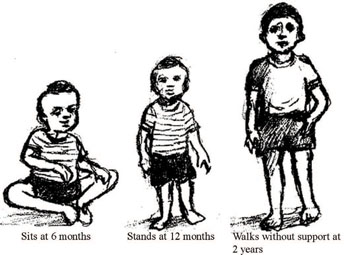When children develop normally
There are large variations in the way children develop. But there are some characteristics in physical, language and emotional development that all children have in common. Table 17.1 and Figure 17.2 present some important developmental milestones (significant events in development that are achieved by most children around a particular age) in early childhood. The exact age by which these milestones are achieved varies from child to child, but when there is a serious deviation from these typical developmental milestones, there is reason for concern. In the following sections we will discuss a few important conditions in which the typical development is delayed or abnormal.
Table 17.1 Normal childhood developmental milestones.
| Age | Physical development | Language development | Emotional development |
|---|---|---|---|
| 0–1 years | 4 months: sits with support 8 months: stands 9 months: crawls | 4 months: laughs aloud 8 months: repetitive responding 10 months ma-ma, ba-ba | Issues of trust are key 9 months: stranger anxiety; exploratory and solitary play 10 months: plays peek-a-boo |
| 1–2 years | 13 months: starts to walk 2 years: walks alone | 2 word sentences | Imitates No is favourite word |
| 2–3 years | High activity level Eats, drinks by self | Parents understand more of what the child says | Selfish Imitates mannerisms and activities May be aggressive |
| 3–4 years | Toilet trained. But bladder control may be delayed up to the age of 5 years | Complete sentences Understands much more | Gender-specific play Takes turns Knows full names and gender |
| 4–5 years | Hops on one foot Avoids simple hazards | Can tell stories | Nightmares and fear of monsters Imaginary friends |
| 5–6 years | Complete toilet control | Asks the meaning of words | Important to conform with peers |

Figure 17.2 Examples of developmental milestones.
Last modified: Monday, 23 June 2014, 11:49 PM